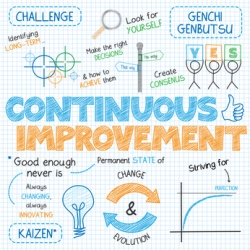JFK once said « Things do not happen, they are made to happen » and Mark Hurd, CEO of Oracle may have been thinking of JFK when he chose Employee Engagement as the topic for his address at the opening keynote session of Oracle HCM world in Chicago recently (see The Compelling Case for Employee Engagement).
Employee engagement deals of course with how deeply an employee connects with his/her company and how willing he/she is to « go the extra mile » to get the job done well.
 When employees are engaged, they think not just “what’s in it for me?” but “what’s in it for us?”.
When employees are engaged, they think not just “what’s in it for me?” but “what’s in it for us?”.
Employee engagement is of course a “hot potato” for all organizations the world over as between 30% and 50% of employees declare themselves to be disengaged to greater or lesser degrees, depending on the Survey and the region.
So why did the CEO of a global High Tech company chose to handle such a “hot potato” in such a public way?
Engagement: a Productivity driver!
The reason is simple. Mark Hurd chose to discuss engagement, because he considers the topic as not just a noble gesture but a real « productivity » mechanism that contributes directly to the company’s bottom line. And Mark Hurd was ready to admit that increasing engagement from 70% to 80% at Oracle would deliver around 2 Billion USD in savings! That’s a huge impact!
«The team with the best help for their business model usually wins », Hurd continued and we all know that to win outside, you have to win inside. Of course, over the past few

years, due to the economic downturn, many companies have compensated for sluggish growth by cutting costs. But as Hurd reminded his audience, there is another way to cut expenses: “raise employees’ productivity and get more output for the same investment”. As Hurd said, “more highly engaged employees do more work, do better work, care more about your customers, they perform better and so does the whole entity”.
Not just a Millennial issue!
What’s more, it is not a generation thing with millennials being somehow more disengaged than Generation Xers or Baby Boomers. As Hurd pointed out, all generations seek more or less the same things, have more or less the same expectations and are more or less engaged.
So what drives Engagement?
So what do employees expect? What drives higher engagement and what can we do to influence these drivers positively?
Research on Employee Engagement identifies many key drivers of employee engagement. Below are a few of those key drivers and some suggestions on what we can do to live up to JFK’s words and make things really happen rather than wait for them to happen! Some of these actions may well be on the Oracle Engagement Action Plan!
1)Company Purpose
Not surprisingly, engagement is not only about money!
Today, employees want to be paid fairly but they also want to work towards a greater

purpose and to do work that really matters. At its core, a company’s purpose is a bold affirmation of its reason for being in business. It conveys what the organization stands for in historical, ethical, emotional and practical terms. No matter how it’s communicated to employees and customers, a company’s purpose is the driving force that enables a company to define its true brand and create its desired culture. Quite often however, companies don’t formulate their purpose very well and fail to communicate it from top to bottom of the organization.
More importantly, often, there may be a disconnect between the company’s Purpose and the behaviors demonstrated lower down in the organization. Action speaks louder than words and a bold company purpose has to be backed up by coherent behaviors within the organization. Not only Talk the talk. Walk the talk!
Some key suggestions:
- Clearly formulate the Company Purpose and communicate it to the organization top down.
- Start at the Top! Express the Purpose in terms of some key top-level business and management behaviors expected of senior leaders and encourage them to walk the talk!
- Organizing round tables throughout the organization between managers and employees to define simple meaningful behaviors that express the Company Purpose at local level.
- Include these behaviors in leadership and employee learning and development programs.
- Build these behaviors into the annual appraisal process and indeed in the ongoing discussions between managers and employees.
- Recognize and reward employees who demonstrate these behaviors in positive ways and share with the organization as a whole.
2) Company Strategy and Direction
If you don’t know where you are going, you may end up somewhere you don’t want to be and most research shows that employees need to have a clear appreciation of where the company is going and how their own actions are contributing to business results.
This means cascading strategy in a simple, pragmatic way and ensuring that employees’ operational objectives are connected to overall strategy.
Some key suggestions:
- Make Employee Engagement a strategic objective and define the key KPIs to measure improvements to employee engagement. Hold managers and HR accountable for reaching Engagement targets and monitor on a regular basis.
- Of course, use all the classical methods to share and update the company strategy: Annual Kick Offs, monthly All Hands, newsletters, intranet, etc.
- Use the annual appraisal process as a tool to translate the strategy into actionable SMART goals at operational level and to ensure employees connect what they are doing to overall strategy and goals with the help of their managers.
3) Leadership
Employees don’t leave companies. They leave managers!
Most research shows a clear and critical link between an employee’s level of engagement

and his/her relationship with his/her manager. The better the relationship, the higher the engagement. Employees expect today a positive, mentoring type relationship with their managers and more importantly, expect more autonomy, more opportunity to express their opinions and contribute to decision making more frequently and directly.
Some key suggestions for leaders:
- Today, employees expect to have a voice! Empower your team members. Explain the strategy and how it translates for your unit in operational terms, encourage your team members to propose their own objectives and discuss with them as and when these objectives need to be aligned.
- Employees expect regular feedback so meet your team members regularly. Discuss whatever needs to be discussed and position yourself as a coach who wants to help team members achieve their goals. Be hard on the issues, not on the people.
- Employees need to feel trusted so be transparent and share wherever possible information that helps them understand the business.
- Delegate and control: delegate responsibility but always control and hold team members accountable. More empowerment means more accountability.
- Lead by example and walk the talk.
- Seek first to understand before being understood!
- Invite your team members to offer solutions and you will find they will have a lot of ideas.
- Promote a no-blame, continuous improvement approach. If team members can express opinions, admit mistakes and seek to improve, they will be more confident and engage more readily.
- Say thanks regularly and not necessarily with money.
4) Relationship with peers
Most research suggests that a positive work atmosphere and good relationship with peers is critical to employee engagement.
The better and stronger these relationships are, the higher the level of engagement. And the best way to promote great relationships is to develop great teamwork!
Some key suggestions:
- Ensure clarity of purpose – Employees must know what they are trying to accomplish, why, how well, and with what priorities and constraints both as a team and individually and where the two intersect.
- Ensure clarity of roles – Talent and responsibilities must be well-matched so employees feel challenged but with a fair shot at excellence.
- Ensure clarity of process – Employees must understand how the game is played, know where things stand, know how they can best contribute, believe decision-
 makers are informed and fair, and believe they can influence the process if things are going awry.
makers are informed and fair, and believe they can influence the process if things are going awry. - Recruit eagles and teach them to fly in formation! On boarding is critical and engage with new starters as of day One!
- Use the annual performance review as a way of updating on roles and responsibilities and on monitoring skills required to do the job on an ongoing basis.
- Encourage Cooperation and not Competition. Reward cooperation as much as possible because effective teamwork delivers exponential results above anything star performers can do!
- Keep things simple and put people first.
- Defend your team in times of trouble. It’s a great way to build trust. All for one and one for all! When things go wrong, examine first the process and see how the team can improve together.
5) Continuous Improvement
Research consistently shows that engaged employees not only want to do a great job today but want to improve continuously and expect their organization to promote a continuous improvement culture.
One concrete way of promoting a continuous improvement mindset is by constantly seeking employee feedback and involving employees not only in identifying the problems but also in offering the solutions.
Some key suggestions:
- Promote a culture positive to feedback. Deploy an annual survey of course but don’t wait for the once in the year audit results to find out what employees think. Seek feedback frequently and multiply the channels for obtaining feedback.
- Feedback is a gift. Engaged employees want to contribute and care about what they are doing so accept the feedback, however critical it may seem. Don’t seek to punish or reprimand and don’t prejudge why employees respond the way they do. Take the feedback as it is.
- Involve managers, team members and HR not only in analyzing the results but also in defining the action plans together so that all parties are part of the solution not the problem.
- Recognize and reward teams for continuous improvement suggestions that are implemented successfully and share throughout the organization.
6) Career development
Engaged employees have high expectations with regard to how their careers are being developed and want to believe they can grow with the organization.
Some key suggestions:
- Use the Annual Performance Appraisal as a Career Plan for each employee and to discuss strengths and development needs, roles and responsibilities, how to stretch the employee in his/her current role, what roles the employee can target as a career step and what skills are needed to succeed the move. Set loose career goals with each employee and discuss progress year on year.
- Promote a learning and development culture. The annual performance review is the best place to set some SMART learning objectives for each team member to help him/her progress on his/her career plan.
- Learning doesn’t only need to be classroom based and can also involve coaching, new assignments and responsibilities, special projects, etc.
7) Compensation & Benefits
Most research shows that employees expect to be treated fairly compared to their

colleagues in terms of compensation and benefits and expect decisions concerning compensation and benefits to be taken as objectively as possible.
However, research also suggests that while compensation is a contributing factor in employee disengagement, it is rarely a critical factor, especially when it comes to deciding whether to go or stay!
Some key suggestions:
- Be transparent on the process. Explain the rules upfront to all employees concerning how compensation & benefits plans are built, how salary increases and bonus awards are decided, by whom and with whom, when and where and give employees the opportunity to share their expectations early with their managers before decisions are finalized.
- Train managers of course in the fundamentals of Comp & Ben and how to discuss with employees the salary review process.
- Promote a “Total Compensation” approach which highlights all the different components of the employee’s compensation and not just base and variable.
- Don’t forget other Benefits because Base pay is not everything and research often shows that employees are ready to forego a raise for a good perk such as a health plan or retirement plan! Research also shows that for most employees, pay and benefits do not pay a significant role in decisions to change job. Culture and values, career opportunities and senior leadership have a more direct impact on employee satisfaction and therefore on employee retention! Food for thought.
So lots to do and great challenges indeed to reinforce employee engagement from a leadership and organizational point of view.
Of course, employees have their own part to play in developing their engagement levels and we’ll discuss in a later blog.
Like the painting of the Eiffel Tower, it’s a never-ending battle but one that is worth the effort and investment!
What do you think?




 notably, the Plan, Do, Check, Act (PDCA) cycle created by Prof. W. Edwards Deming and
notably, the Plan, Do, Check, Act (PDCA) cycle created by Prof. W. Edwards Deming and


